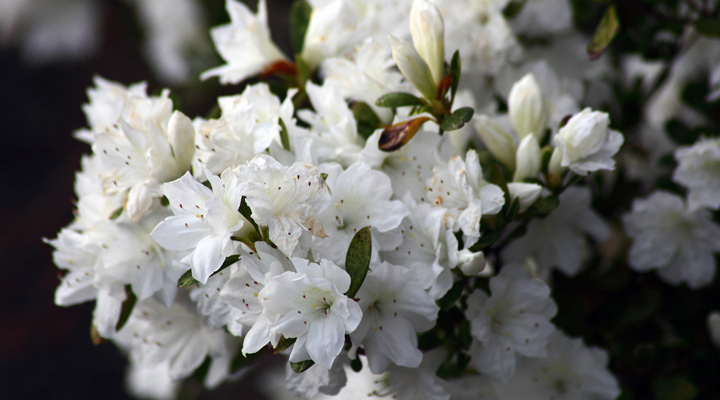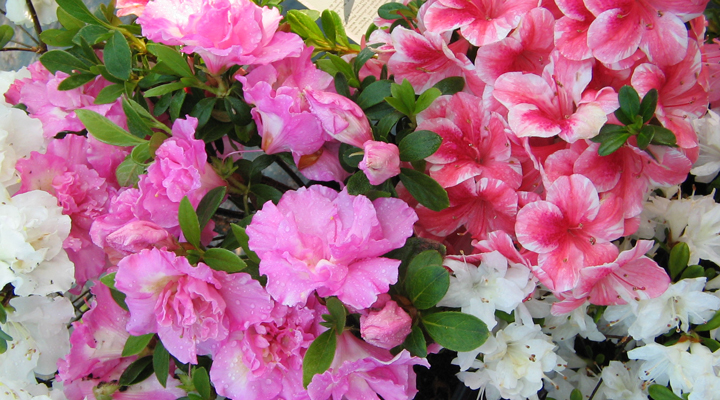Azaleas
I had always thought of azaleas as small plants until one day I visited an old Sydney garden and found myself walking through a tunnel of shrubs. Wondering what they were, I looked up and discovered azalea flowers above my head. These plants, which were decades old and had never been pruned except to create space to walk, had grown 3m or more tall.
Azaleas are evergreen shrubs in the Rhododendron genus. Most grow 1-2m tall and many are smaller. They are at their peak from late winter to spring when they are in full bloom. Azaleas flower generously and many varieties also bloom at other times of the year, a habit called ‘spot flowering’.
These plants are originally from Asia where they grow in woodlands. Today’s azaleas have come a long way from their wild relatives. They flower in many colours (including white, pink, salmon, lilac, purple, red and variegated) and in a range of shapes and sizes from large and single, to hose in hose (a form of azalea where that appears like one single flower in another), double or ruffled. Some azaleas are perfumed.
Many grown today have been bred to thrive in containers in partly shaded areas such as courtyards. For larger, stronger growers for a shrubbery, woodland garden under trees or as a hedge, seek out older varieties such as ‘Alba Magnifica’ (white), ‘Splendens’ (salmon), ‘Magnifica’ (purple) and ‘Alphonse Anderson’ (pink with white edge and dark pink throat) all of which have large, single flowers. These varieties also grow well as standards – that is, specimens trained with a single stem and ball of growth.
As well as these stalwarts, there are strong growers with more ornate flowers. ‘Red Wing’ (red), ‘Happy Days’ (purple pink) and ‘White Bouquet’ (white) have large, ruffled flowers on a medium-sized shrub. ‘Kirin’ has small semi-double pink flowers. All grow to around 1m high.

Azaleas make a beautiful addition to the garden.
Care and maintenance
For all their radiance, azaleas have an Achilles heel. They require the use of sprays to keep them in good health.
Their magnificent flowers are prone to a disease called petal blight, which causes the flowers to wilt as if the shrub is water stressed. As the disease progresses, the flowers become brown and remain on the plant. The disease is spread by wind and water.
The only remedy is to apply a fungicide as the buds begin to show colour in late winter or early spring and reapply fortnightly during flowering. Flower Power recommends Mancozeb Plus. Shear over plants as they finish flowering to remove any disease-infected blooms. Collect up diseased flowers and dispose of them into the garbage bin (do not compost).
Feed azaleas after they have flowered applying an azalea and camellia food (follow application instructions on the container). Flower Power recommends Kahoona. Azaleas also benefit from a mulch of aged cow manure, such as Supersoil Cow Manure Blend.
As new growth appears, the plants are vulnerable to pest attack from either azalea lace bug or two-spotted mite (also called red spider mite). Both insect pests feed under the leaves and cause the foliage to develop unsightly mottling. They also reduce the plant’s vigour. Treat lace bug with Baythroid Advanced and control two-spotted mite with Mavrik, otherwise eco-oil is an organic option.
Plants thrive in well-drained soils with added organic matter. Once established, azaleas are drought hardy but new plants and those growing in pots should receive regular watering especially when it is dry or windy.
To rejuvenate overgrown plants, prune hard after flowering, cutting the bush back in stages to avoid pruning shock. Remove around a third of the plant, cutting down to the base of the stem. When regrowth is well established, prune again if temperatures are mild or wait until the following spring to continue the rejuvenation pruning.

Azaleas come in a range of striking colours, sizes and petal formations.
At a glance
Plant name: Azalea
Form: Evergreen shrub
Size: 30cm to 2m+ (depending on variety)
Features: Beautiful winter to spring flowers in a wide colour range
Garden use: Shade to part sun areas, containers, under trees, hedges, Japanese-style gardens, training as standards
Grow with: Australian natives, camellias, mondo grass, clivia, deciduous trees
Soil: Well-drained, slightly acidic (pH 5.5) - in pots, use a specialty mix such as Supersoil Professional Gardenia, Camellia & Azalea Potting & Planting Mix
Feed: Spring, after flowering
Prune: Spring, after flowering
Problems: Petal blight, azalea lace bug, two-spotted mite (control with registered pesticides)

